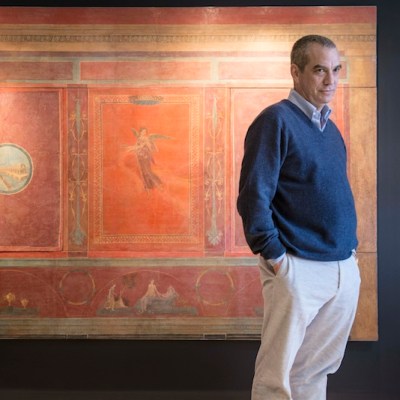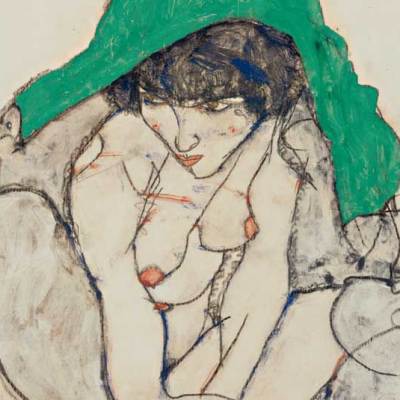Every year, Yale University Art Gallery offers a group of students the chance to curate a public exhibition: this year’s focus is on book art from the Allan Chasanoff Collection. We spoke to one of the curators, Jessica Kempner, about the curatorial process, and how the group’s understanding of the genre changed over the course of the year. Instead of asking what book art is, perhaps it is better to consider what it can say, and the issues it has been used to address…
Click here for a gallery of highlights from the exhibition
Can you tell us a bit about the exhibition?
‘Odd Volumes’ is a collection of works of art united by their association with the book. The nature of these objects both in terms of form and artistic inspiration cannot easily be classified. We did notice, however, a thread between some artists who were working with books to comment on the obsolescence of the paginated volume in a technology-driven context.
What makes this a distinctive show?
The content of the show is very unusual and makes for an exciting installation. For instance, a very small number of the objects are wall-hung. Objects of all shapes and sizes are displayed in unusual ways, resulting in a visual field that will be filled from top to bottom and left to right. Another special element of this show is its relationship to a companion exhibition at Artspace, a non-profit arts organisation in New Haven. Artspace has a few objects from the collection, and has invited artists to respond to these works. It will be presenting the original works with the new ones in a simultaneous exhibition.
How did you come to curate this exhibition?
I am one of six student curators. I worked with three other undergraduates (Elizabeth Mattison, Sinclaire Marber, and Colleen McDermott) and two graduate students Ashley James and Andrew Hawkes, to develop the show. The gallery has afforded students from all academic backgrounds the invaluable opportunity to curate exhibitions since 2006. Over the year we selected 104 works from Allan Chasanoff’s collection of approximately 300, compiled a beautiful exhibition catalogue, and designed and installed the final display.
What is likely to be the highlight of the exhibition?
Given the nature of the collection – a large stock of diverse objects – there are likely to be many highlights. My personal favourite right now (mind you, this changes regularly) is Adele Outteridge’s Vessels. This work, when closed, mimics the outward form of a book. However, due to its lack of a true spine and clear Plexiglas pages connected by white and black linen thread, the negative and positive spaces of the work take on an incredible sculptural quality when it is opened.
And what’s been the most exciting personal discovery for you?
When I began to work on the show, I was completely unfamiliar with book art as a genre. I distinctly remember our first meeting at Yale’s West Campus, where the collection was stored prior to installation, when we saw a huge portion of the works for the first time. We were struck by the heterogeneity of the collection. In the early stages of the process, we found ourselves continually asking, ‘what is book art?’ As we found out more about the collection, however, we began to realise that there is no uniform definition, but a group of common themes with which the works seem to be grappling. We isolated these themes and, in so doing, realised that many of the works are enmeshed within multiple issues. We strove to replicate this interconnection between motifs and specific objects in the final exhibition.
What’s the greatest challenge you’ve faced in preparing this exhibition?
As is to be expected, each curator had preferences for some works, distastes for others, and visions for how he or she wanted to develop the show. To be honest, I expected these differences in opinion to be more frequent and potentially more heated. In fact, I’m pleased that the exhibition we have created really reflects elements of our individual tastes but also shows our cohesive vision, which developed as we delved deeper into the collection and grew as a team.
 How are you using the gallery space? What challenges will the hang/installation pose?
How are you using the gallery space? What challenges will the hang/installation pose?
Our exhibition is certainly a different animal from many of the displays that have been mounted on the Louis Kahn building’s fourth floor. We worked very hard to create a dynamic and multidimensional show that highlights the eccentricity of the book art. A specific challenge that we faced was the hanging of one of our favourite works, Cheryl Sorg’s Surely All Is Not without Meaning (Moby Dick). The work, which should be wall-hung, is far too large for the walls in the space. After toying with other presentation ideas, such as placing the object on the floor, we decided to place the work in the lobby where visitors will also see Long-Bin Chen’s Punishment #1 and The Reading Room.
Which other works would you have liked to have included?
The exhibition is filled with so many incredible gems that I cannot think of a work that I wish had been included. I do wish, however, that there was more opportunity to touch and manipulate the books. It is very difficult – for me, at least – to see a book and restrain from opening it and turning its pages. The books’ presence in a museum, however, precludes this type of engagement. We have attempted to present the books in a manner that shows as much as possible. For some of the pieces, we will actually be turning the pages throughout the duration of the exhibition. We are offering a prize for the person who correctly identifies each page flip! Just kidding, but these changes to presentation are yet another reason to visit ‘Odd Volumes’ more than once!
‘Odd Volumes: Book Art from the Allan Chasanoff Collection’ is at the Yale University Art Gallery from 7 November–1 February 2015.



